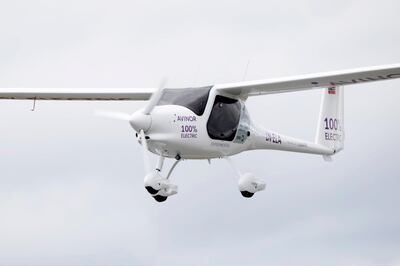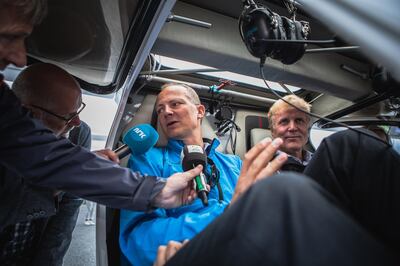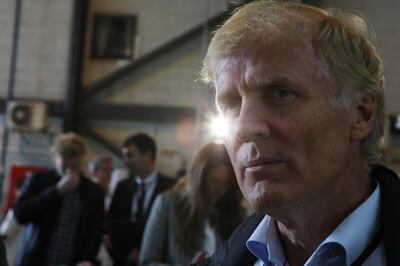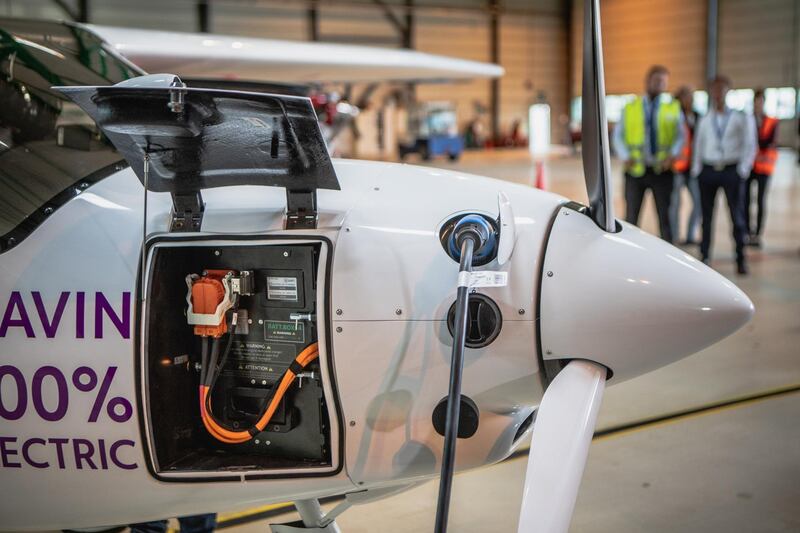Home to some of the busiest flight routes in Europe, whisking passengers across a rugged and mountainous landscape, Norway’s aviation industry now readies to go electric.
Norway is one of Tesla’s biggest markets, with about 8,500 cars sold last year. Now, the country whose tourism sales pitch is "Powered by Nature" wants to be a pioneer in the market for electric planes. Wideroe, a local airline that operates small planes on short haul flights, sees no major technological barriers ahead and plans to launch its first commercial aircraft propelled by some form of electric power within the next 10 years.
“Today, we fly the smallest aircraft on the shortest routes, based on an ageing technology that was developed in the 1970’s,” Wideroe’s chief executive Stein Nilsen told Bloomberg. "There’s been much development in the aviation sector, but not on the smallest aircraft."
Monday (June 18) marked the inaugural flight of an electric two-seater plane, which took off from Oslo Airport with the country’s transport minister as a passenger.

The plane, made by Slovenian manufacturer Pipistrel, can fly for up to one hour. Avinor, a state-owned company that operates the country’s airports, say the short test flight demonstrated the feasibility of pollution-free aviation.
Western Europe’s largest exporter of oil and gas has pledged to cut emissions of greenhouse gases by 40 per cent by 2030. About half of all new cars sold there are electric (Germany only recently leapfrogged Norway as Europe’s biggest market for electric cars), and battery-powered ferry boats are also being built. The thrust to electric planes should cut emissions further, though environmentalists are sceptical.
“The growth in both Norwegian and international aviation is one of the big drivers of climate change, which is completely out of control,” said Truls Gulowsen, head of Greenpeace in Norway. "Even if there’s a small chance that we’ll be able to get some small electric aircraft in the air covering short distances, there’s no indication that we’ll be able to replace today’s medium and long haul distances with electric propulsion.”
That message fails to resonate with Wideroe, which likens what’s happening in the aviation industry to the rapid transformation currently underway in the automobile industry.
“Those who need to drive fossil fuelled cars will still buy these cars, but [the industry’s] total emissions are nevertheless coming down,” Mr Nilsen said. "We must have a similar view for the aviation industry."
_______________
Read more:
Faster, higher, safer? Emirates planes could be going windowless
Airbus unveils 3D printing for aviation with Thor
_______________
Norwegian Air, Norway’s largest airline and Europe’s third-largest low-cost carrier, has already expanded its fleet with fuel-efficient aircraft, such as the Boeing 737 MAX. But like other major airlines has no plans to go electric until the technology matures.
“When electric aircraft are able to replace today’s commercial machines, we will of course be interested,” spokesman Lasse Sandaker-Nielsen said.
Wideroe is far more ambitious. It currently operates 40 Bombardier Dash 8 turboprop planes and carries 2.8 million passengers each year. It wants to replace its entire fleet with electric planes by 2030. “We have reached out to manufacturers to motivate them to create an aircraft designed for Norway with a new technological platform,” the Wideroe CEO said.
One of those manufacturers is Zunum Aero, a Boeing-backed start-up that plans to deliver its first hybrid-electric plane to JetSuite in 2022. The plane will have a range of 1,000km and seat up to 12 passengers.
"The price that we're targeting is very much in line with the current aircraft but the operation cost is just a fraction, it's literally 60 to 70 per cent lower than an equivalent aircraft in operation right now," said the start-up's founder Matt Knapp.
“When large research and development resources move in the same direction, things tend to move fast,” Mr Nilsen said. But creating an aircraft that will withstand the unapologetic weather conditions of northern Norway may pose a challenge.
“We don’t see any technological barriers that will make this impossible to achieve,” Mr Nilsen said.
So will we someday be able to fly without the guilt of causing environmental damage?
"Many people say that we must get rid of air transport because we will never be able to deal with emissions and noise, but this is an outdated approach," Norwegian Transport Minister Ketil Solvik-Olsen told AFP recently.

Dag Falk-Petersen, head of Avinor, said: "In my mind, there is no doubt: by 2040 Norway will be operating totally electric."
Air transport's impact on global warming is estimated at around 5 per cent through CO2 emissions and other substances, including nitrogen oxide and water vapour.
As the number of air passengers is expected to almost double by 2036 to 7.8 billion per year, according to the International Air Transport Association's (Iata) projections, aviation's impact is on a course to increase substantially if nothing is done.
"Aircraft producers see that they have to do [something] because otherwise there will be a new Tesla taking their positions," said Mr Falk-Petersen, referring to how the US electric car manufacturer has shaken up the traditional automobile industry.

Airbus aims to develop a hybrid model called E-Fan X, and has teamed up with British engine maker Rolls Royce and German industrial group Siemens. The first flight is planned for 2020.
"One of the biggest challenges is electricity storage," said Glenn Llewellyn, general manager for electrification at Airbus.
As with cars, the performance of batteries is a critical element, with the added problem that they are heavier than fuel and carrying them into the air is the most-energy intensive part of the flight.
"But at the same time battery technology is probably the technology in the world which has the most investment. So it will evolve," added Mr Llewellyn.
The expected lower operating costs of electric planes, both due to cheap electricity and simpler motors, means that the highly competitive airline industry could end up adopting them quickly.
Airbus offered several years ago updated aircraft with 15 per cent fuel savings, and as jet fuel is a major cost for airlines, they quickly placed orders for thousands as they tried to get ahead of rivals.
The transition to electric could also provide another advantage: they are much quieter, meaning they may win exceptions to restrictions imposed due to noise near residential areas.
Combined with the fact that electric planes don't need such long runways, they could be used at some smaller airports close to city centres.
Avinor said switching to electric would also help airlines avoid any climate change related penalties that regulators could impose, such as higher taxes and flying restrictions.
Norway sees itself as a good test bed for electric planes.
"There are a lot of issues to deal with, with icy conditions, with heavy winds," said Mr Nilsen.
"But if we can do that here in Norway, I'm certain that this air plane will cope with any conditions in any place in the world."







